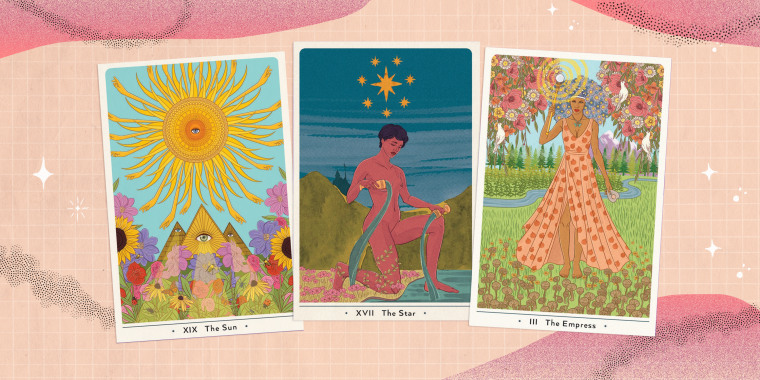Afros. Saris. Sphinxes. Rainbows.
These are some of the striking images found in actress Rachel True’s new tarot deck and guidebook — “True Heart Intuitive Tarot” — released this month with a decidedly multicultural bent. Best known for her starring roles in the 1996 cult hit “The Craft” and the 2002 sitcom “Half & Half,” True has studied tarot for most of her life and wanted her guide to reflect the diversity of her New York City birthplace.
True’s tarot cards, illustrated by Toronto artist Stephanie Singleton, stand out for their inclusive imagery.
“I wanted it to be representative of the world around us,” said True, a rare woman of color to release a deck with a major publisher (Houghton Mifflin), who in 2017 completed a stint as a tarot reader at the House of Intuition in Los Angeles. “I just wanted to have as many skin tones and flavors as we could possibly get in there, and I’m happy about that because I know, for me, when I was reading books and looking at decks, they were all very homogenous.”
Having gained popularity as a parlor game in 15th century Italy — though some have linked them to Mamluk playing cards from Turkey and mystical imagery from Egypt — tarot cards are now widely used for divination and include symbolism that reflect life’s lessons and challenges. But the most established tarot decks have a European aesthetic, which can make it difficult for people of color to connect with them.
Fans have already told True that her collection, which contains both personal essays and card interpretations, is their first time purchasing a metaphysical product by a Black person. Born to a Black mother and a white Jewish father, the actress calls her book release no “small feat” for a woman of color.
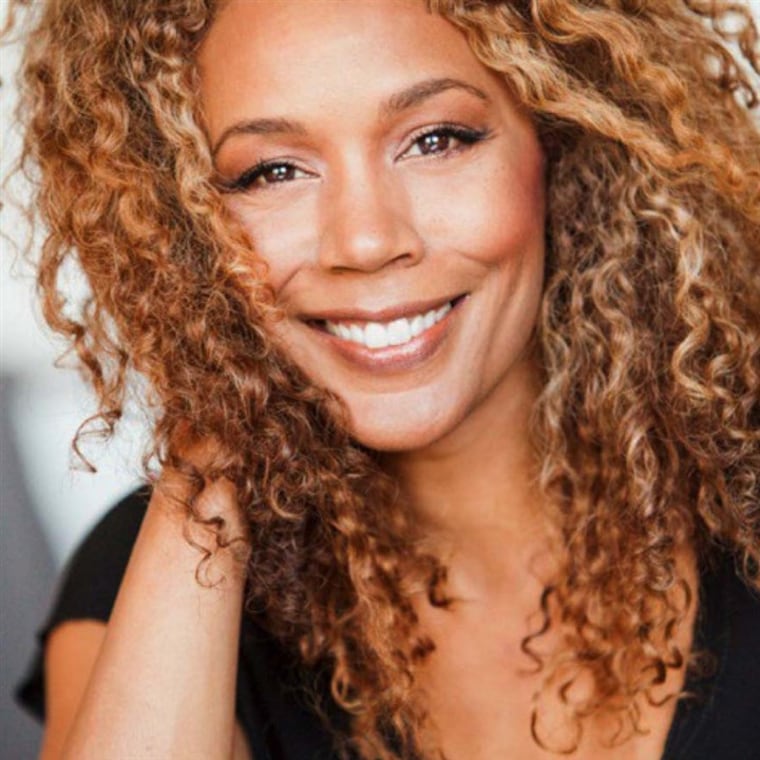
True follows in the footsteps of other Black artists and creatives such as Courtney Alexander, Manzel Bowman and Tayannah Lee McQuillar who have released tarot decks highlighting Black beauty, culture and experiences in just the last four years. These creators are part of a shift among Black people embracing the mystical and “the dark”: According to the Pew Research Center, the percentage of Black people who identify as spiritual but not religious rose from 19 percent in 2012 to 26 percent in 2017, which is roughly the same percentage of Americans overall who now identify this way.
Black women in particular have launched Black girl magik meetups, witchcraft conventions, hoodoo festivals and goth clothing lines. In addition to writing about tarot, they’ve written books about witchcraft, astrology and the Black gothic, tying these traditions to their cultural and artistic heritage.
But the desire to heal is the major reason these practices appeal to Black women, according to Yvonne P. Chireau, a professor and chair of the religion department at Swarthmore College and author of the 2003 book “Black Magic: Religion and the African American Conjuring Tradition.”
“Black women seem to have more of what I would call an orientation to the therapeutic, and that has been consistent,” Chireau said. “It’s not just about women’s power and witchcraft, and all these wonderful things that the white feminists were about. For almost every Black woman that I know who’s involved in any of these traditions, it comes down to the purpose of this work is ultimately about healing — and not just bodies but healing spirits. So, you won’t necessarily find them out there trying to do spells to remove Donald Trump.”
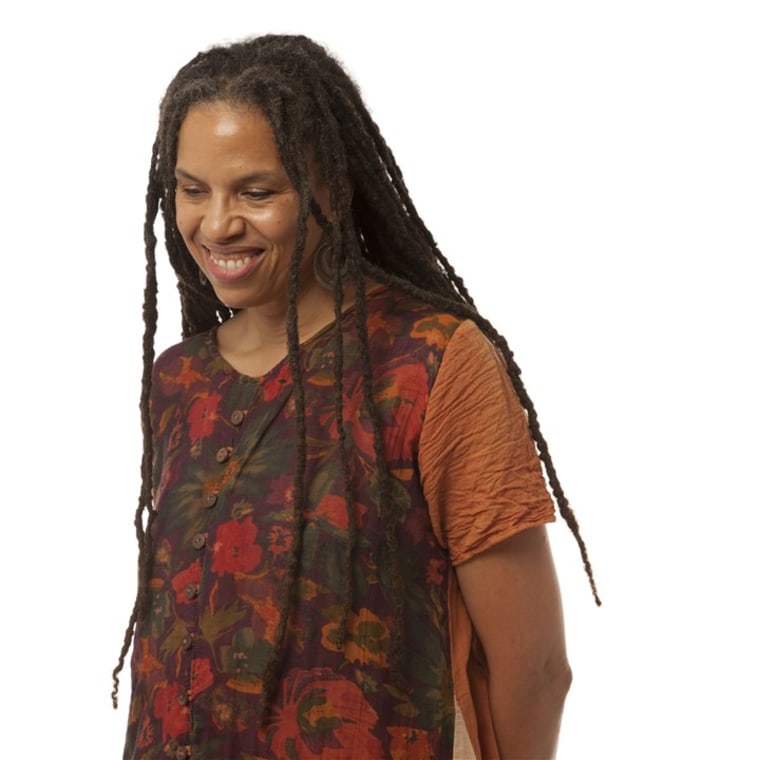
That’s a reference to the widespread media attention mostly white feminist witches garnered in 2017 for their ongoing spell to “bind” Trump — using a photo of him, the Tower tarot card, a candle and other accoutrements — until his exit from office. The spell highlighted the link between second-wave feminism and the New Age movement, both of which have faced criticism for sidelining and appropriating people of color. Since Black women were never centered in these movements, it’s not surprising that their current interest in mysticism may have more to do with healing themselves and their communities than with the current occupant of the White House.
An admirer of the Swiss psychiatrist Carl Jung, True regards tarot decks as essentially “a shrink in a box.” In her book, she recounts how tarot helped her process a difficult childhood. She said her exposure to books such as Jung’s “Man and His Symbols” and Nietzsche’s “Beyond Good and Evil,” along with the tarot, helped to ground her as she grew up.
“You can look at them, and see where they hit you on a visceral level,” she said of the tarot. “I follow a Jungian tradition of tarot, so my interpretation tends to lead you down the path to examining yourself because if there’s one thing I know it’s that I can’t change anyone else. I can only work with myself and shift my own behaviors and perceptions. That’s why I like tarot.”
Although True is passionate about tarot, she doesn’t view it as a practice of the occult, a term she said has negative connotations. Instead, she views tarot as a way for people to tap into their intuition. Similarly, she doesn’t identify as a witch, despite playing one of Hollywood’s most iconic African American witches — Rochelle in “The Craft.” The follow-up to that film, “The Craft: Legacy,” debuted this week and will likely introduce a younger generation to the 1996 version as well.
New Yorker Mya Spalter grew up watching the original “Craft” and appreciating seeing a witch of color. Growing up with a Black Catholic mother and a white Jewish father, Spalter said that she can’t remember not feeling like a witch — “I was always a weird kid” — because of her love of nature. It helped that neither of her parents emphasized their religion to her or made her feel that any form of spirituality was off limits.
She ended up working at New York City’s oldest occult shop, Enchantments, and wrote a 2018 book about the experience and the basics of witchcraft, “Enchantments: A Modern Witch’s Guide to Self-Possession.” With humorous pop culture asides, especially about the ’90s R&B group Bell Biv DeVoe, Spalter’s book not only demystifies witchcraft but also sends the message that one can be a practicing pagan using common household ingredients such as salt, lemon and olive oil—a contrast to the Instagram witch aesthetic where photos of altars with expensive crystals, feathers and stones get thousands of likes.
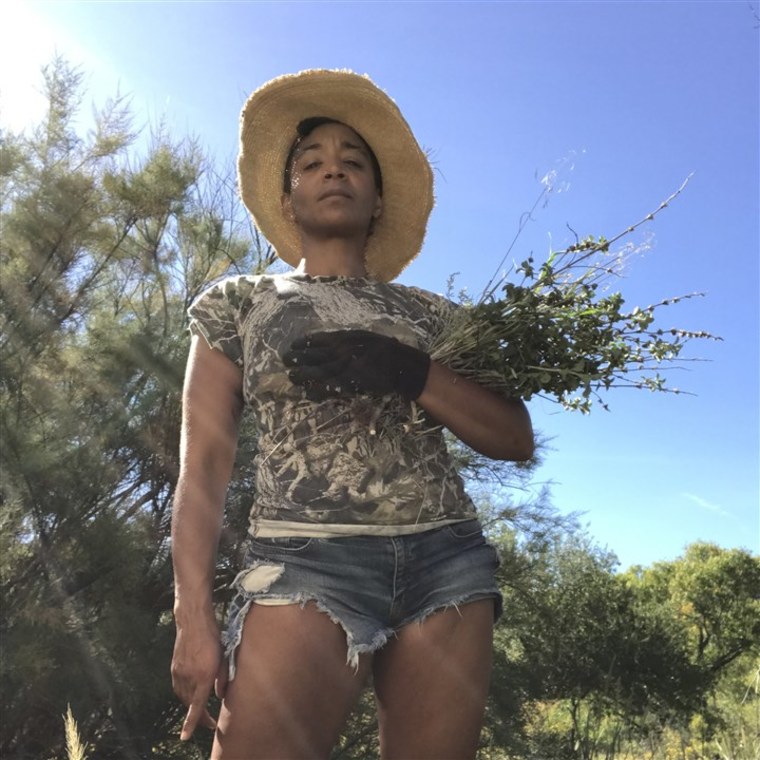
The idea that a witch has to look a certain way, have a photo-ready altar or identify with Celtic traditions are some of the reasons Spalter said people of color hesitate to label themselves witches. Instead, they might identify with religions or folk practices rooted in traditional African spirituality such as Santería, Vodou or hoodoo. Others might not be fully aware of their family’s connection to such religious practices. Spalter said that some people have lightbulb moments: “Wait a minute — witchcraft — is that like what my grandpa did?”
The term “witch” has both a cultural and social meaning, Chireau said. “As for my own understanding,” she explained. “I think that a witch is a person who claims the power to heal and to harm, by spiritual and magical means.”
When her book “Black Magic” was first published nearly 20 years ago, she said, few others had written about the history of African American healing traditions such as rootwork and hoodoo. Now, Chireau is not seeing scholarly works about these customs so much as she’s seeing a wave of how-to books from Black women about various mystical practices—from folk magic to astrology to tarot. And on social media, she encounters many people who are spiritually eclectic, meaning they might follow a West African religion like Ifá but also practice astrology.
Historically, African Americans have weaved in aspects of Indigenous African spirituality with Christianity, making the mix of religious practices a tradition in Black communities. But Hollywood has long demonized traditional African religions in horror films and TV shows, a reflection of the way these spiritual practices were regarded in larger society.
“We didn’t know anything about African religions, which is where it all starts, right?” Chireau said. Those who practiced these faiths were often shown as “awful, pagan, idol-worshipping heathens who happen to be Black, and so you can rationalize enslaving them.” When magic is portrayed on screen, she added, “you don’t see the healer or the hard work of healing.”
Mecca Woods, author of the 2018 book “Astrology for Happiness and Success” bristles at how Black witches in film and TV shows are routinely portrayed as evil or have “unfortunate demises.” As a Black woman astrologer, she’s sometimes subjected to reductive or negative stereotypes, like being called Miss Cleo — the late spokeswoman for a psychic telephone hotline.
After the publication of her book, which shows readers how they can use astrology in their everyday lives, Black people reached out to tell her how excited they were to read an astrology book by a Black woman. Thelma Balfour’s 1996 book, “Black Sun Signs: An African-American Guide to the Zodiac” was one of the last astrology texts by a Black woman to garner significant attention.

“I remember gravitating to it because it was a Black woman who was writing about astrology, and I had never seen anything else like it before on the market,” said Woods, who has practiced astrology for a decade and also hosts a podcast on the subject.
Although some Black people, especially religious conservatives, may hesitate to embrace any form of divination, Woods said that the Black people she encounters have grown more open to what she labels “esoterica.” They are realizing, she said, that these traditions have always existed: “We’re in a space right now where we’re reclaiming these traditions.”
The American gothic is one tradition that Leila Taylor reclaims as heavily African American in her 2019 book “Darkly: Black History and America’s Gothic Soul.” The violence and dehumanization Black people endured during slavery and segregation have haunted them — and the nation overall — influencing their music, literature and other cultural artifacts.
“Toni Morrison’s ‘Beloved’ is a gothic novel; it’s a ghost story, it’s a haunted house story,” Taylor said. “It is influenced by a true story having to do with the horrors and the terrors and the ramifications of slavery. And the same thing with ‘Strange Fruit.’ Beautiful song with this combination of the scent of magnolias sweet and fresh and then this horror — this kind of grotesque imagery, the smell of burning flesh. It was inspired by an actual specific lynching.”
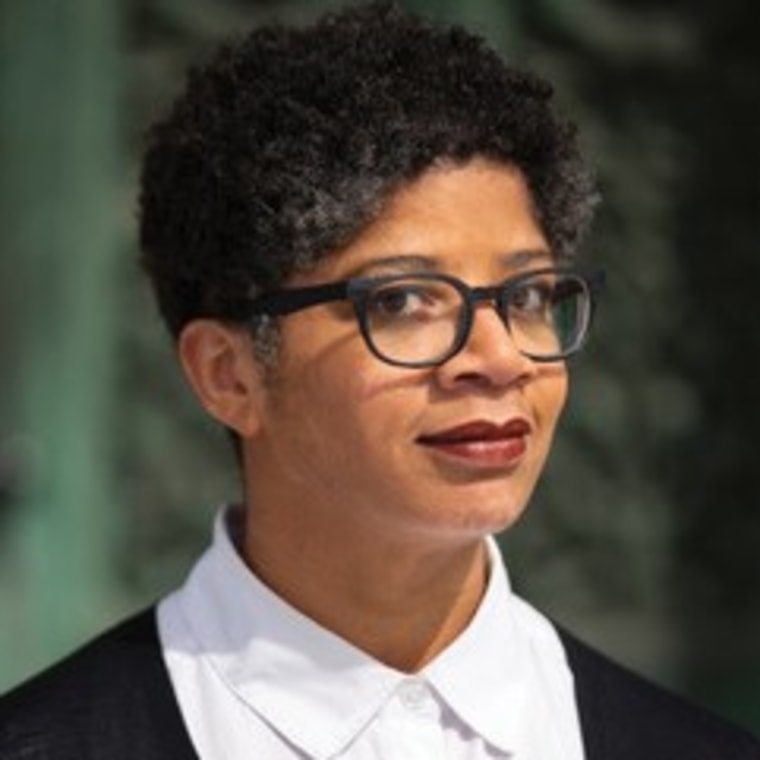
Black Americans have lived with fear, anger and sorrow for generations, Taylor said, and those emotions inevitably seeped into their art. Across racial groups, however, Taylor has noticed a pronounced fascination with witchcraft and the occult. For Black women specifically, mysticism’s appeal is about empowerment and taking up space in a world that often marginalizes them. But the attraction to darkness, Taylor said, is also rooted in healing trauma. The recent wave of Black horror movies and television shows have allowed African Americans to confront their fears in a safe space, she explained.
For the horror movie star True, tarot has been that safe space. It not only helps her to self-soothe and make better decisions, it also connects her to the “old ways” of experiencing life.
“For Black people, let’s think about a time not that long ago where we really didn’t like to go to doctors, and we certainly didn’t go to therapists,” True said. “So that old woman in the neighborhood who could tell you something about yourself — she was the therapist, right? That’s been a long tradition in Black American history, so I believe some of the old ways are in tandem with what people believe now.”
This article originally appeared on NBCBLK. Follow NBCBLK on Facebook, Twitter and Instagram.
